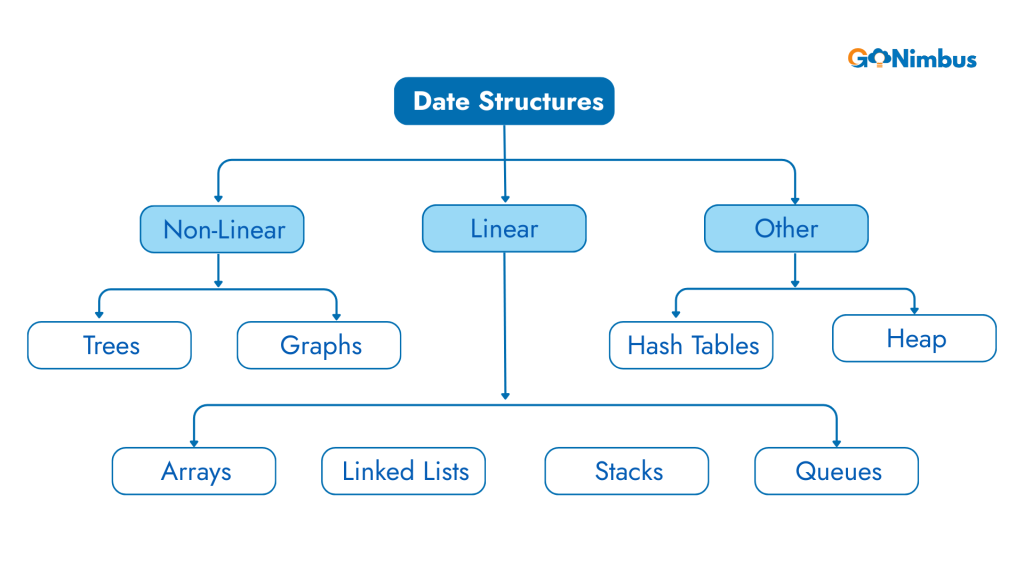….
🌟 DSA Tutorial: Master Data Structures and Algorithms with GoNimbus
Data Structures and Algorithms (DSA) form the foundation of computer science. They give us the tools to organize, store, and process data efficiently, while also teaching us how to solve problems step by step in a logical way.
- Data Structures are about how data is stored and organized.
- Algorithms are about how problems are solved using those data structures.
Together, DSA helps us transform raw information into meaningful solutions — powering everything from search engines to navigation systems.
💡 With GoNimbus, you’ll not only learn DSA theory but also practice with interactive examples, visual diagrams, and coding challenges to build mastery faster.
What are Data Structures?
A data structure is simply a way to arrange and manage data so it can be used effectively.

We choose a data structure depending on:
- What type of data we have
- What kind of operations we want to perform
🔎 Example:
Think about a family tree. It shows how people are related across generations. If you want to know who your grandmother is, the family tree structure makes it easy to trace the links.
Similarly, in computer science, we use structures like arrays, linked lists, stacks, queues, trees, and graphs to make searching, storing, and retrieving data simple and efficient.
👉 Without the right data structure, even powerful computers can struggle to process large amounts of data.
Types of Data Structures
- Primitive Data Structures
- The basic building blocks provided by programming languages.
- Examples: integers, floats, characters, booleans.
- Abstract Data Structures
- Built on top of primitive types, designed for specific purposes.
- Examples: arrays, stacks, queues, linked lists, trees, graphs, and hash tables.
These abstract structures are the backbone of most algorithms you’ll learn.
What are Algorithms?
An algorithm is a step-by-step process to solve a problem or achieve a goal.
📋 Everyday Example:
A recipe for French fries is an algorithm — it lists the steps (cut potatoes, heat oil, fry until golden) that lead to a result (crispy fries).
In computer science, algorithms are written in programming languages and work with data structures instead of food ingredients.
Efficient algorithms are crucial:
- They make programs run faster.
- They reduce memory usage.
- They can turn an impossible problem into a solvable one.
Algorithm Examples in the Real World
- GPS systems finding the shortest route.
- Search engines ranking results.
- Social media feeds sorting posts by relevance.
- Databases retrieving records quickly.
- Games calculating the next move in milliseconds.
In this tutorial, we’ll explore both basic algorithms (like Bubble Sort, Linear Search) and advanced ones (like Dijkstra’s Algorithm, Dynamic Programming).
Data Structures + Algorithms = DSA
Neither data structures nor algorithms work well on their own.
- A data structure without algorithms is like a filing cabinet with no way to find documents.
- An algorithm without a data structure is like having a recipe but no ingredients.
Together, DSA helps us:
- Store and retrieve data efficiently
- Reduce complexity in software systems
- Build scalable, real-world applications
Why Learn DSA?
DSA is everywhere in software development. Some examples include:
- Operating systems: process scheduling
- Databases: indexing and searching
- Web applications: user session handling
- Machine learning: data preprocessing and optimization
- Cybersecurity: encryption algorithms
- Games: pathfinding and decision-making
Mastering DSA means you can solve problems faster, smarter, and more systematically — a must-have skill for developers.
Key Concepts You’ll Encounter
| Term | Description |
|---|---|
| Algorithm | Step-by-step instructions to solve a problem |
| Data Structure | A method to organize and store data |
| Time Complexity | How fast an algorithm runs as data grows |
| Space Complexity | How much memory an algorithm uses |
| Big O Notation | Describes time/space complexity in standard terms |
| Recursion | A function calling itself to solve smaller sub-problems |
| Divide & Conquer | Breaking a large problem into smaller pieces |
| Brute Force | Trying all possibilities until a solution is found |
How to Learn DSA with GoNimbus
- Start with basic data structures and their matching algorithms.
- Move step by step into more complex topics like trees, graphs, and dynamic programming.
- Practice with interactive examples, quizzes, and coding challenges.
- Apply what you’ve learned in real-world problems and projects.
👉 Recommended: Follow this tutorial sequentially to build a strong foundation.